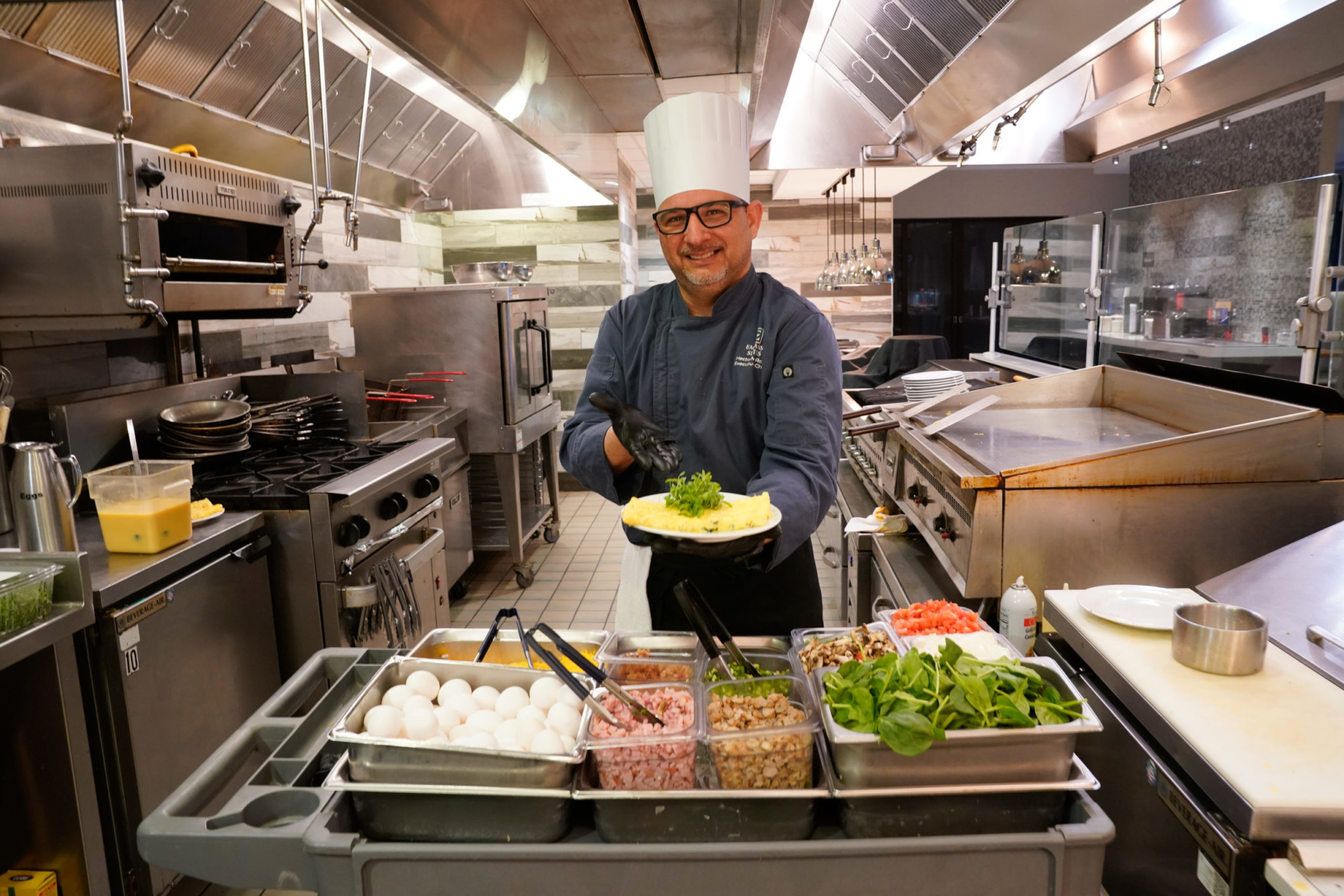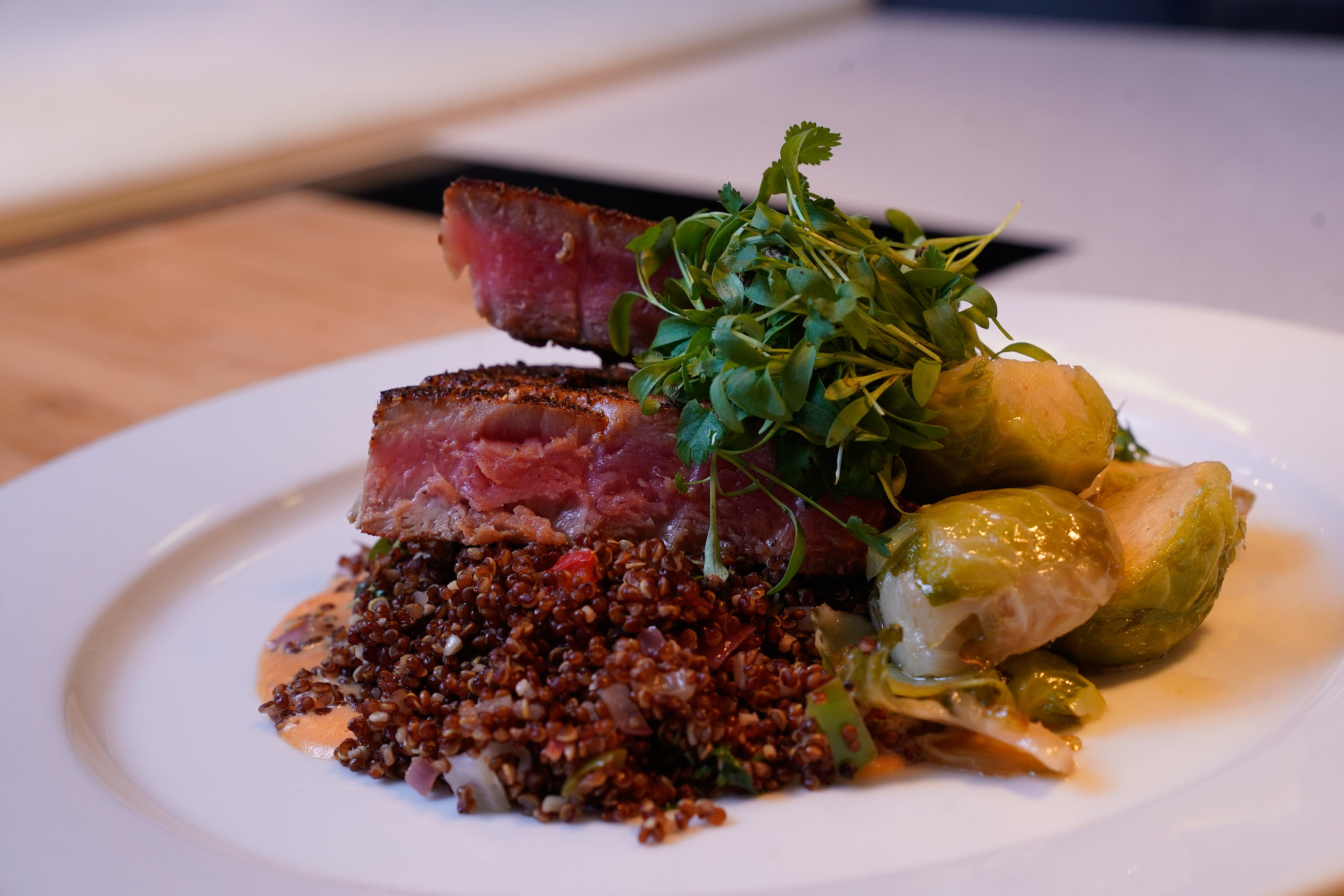Hector Rojas didn’t have a culinary career on his mind when he became a hotel dishwasher at age 17 in his native Puerto Rico.
Soon, however, he felt at home in the busy kitchen and developed a passion for the art of cooking. Then one day, without any training, he stepped in to help prepare the food. A few years later, he was an executive chef in a restaurant.
“It became my passion. Every time I work a dish and see the faces of the customers, it is my greatest satisfaction,” he said. “If I die and God gives me the opportunity to be born again, I will go back to work in this industry.”
Rojas is now executive chef at 1917 Restaurant at Brooks, the master-planned community that has arisen on what used to be Brooks Air Force Base on the South Side.
He came to San Antonio after Hurricane Maria devastated Puerto Rico in 2017, crushing the restaurant he owned at the time, Bahía House, in the city of Guayama. He and his family moved to Texas, having read that it was a nice place to live. He chose San Antonio because he expected there would be many Spanish speakers here.
“It is a hard industry,” he said of the culinary world. “You need a lot of support from your family because in this industry you work a lot. There are no holidays off; on the birthdays of your loved ones, you cannot be there because you are at the hotel, working hard.”
1917 Restaurant — where Rojas became executive chef in 2019 — is the in-house restaurant at the Embassy Suites by Hilton San Antonio, the only full-service hotel on the South Side. It is one of the brightest lights in the fledgling culinary scene at Brooks, where residents and visitors can choose between local joints such as chef Johnny Hernandez’s La Gloria Mexican Cuisine and chain restaurants such as BJ’s Restaurant and Brewhouse.
Rojas has filled the restaurant’s menu with a diverse array of dishes, many of them influenced by Puerto Rican cuisine, ranging from street tacos and anticucho, or char-grilled skewers, to more traditional hotel offerings such as club wraps, burgers, pizza, pork roasts and steak. The restaurant is named for the year Brooks Field was established and the start of construction of the historic Hangar 9, which was built to train pilots in the U.S. Army during World War I.
Rojas recently sat to discuss how he became a chef, the impact of Hurricane Maria on his life and career, and the growth of the Brooks community. The following has been edited from an in-person interview conducted in English and written answers provided by Rojas in Spanish, his first language, which have been translated into English.
Q: Where did you grow up?
A: I am from the island of Puerto Rico, a town called Guanica that has a lot of history. I am the youngest of three brothers. I am from a poor, humble family, but my parents taught me to respect and be a person who, when I set a goal, I reach it.
Q: Talk about how you ended up in the culinary industry.
A: My start in the kitchen was in 1997, out of necessity, because when I was in my last year of school I had my first child and I needed money to be able to raise my son, Hector. I started working with chef Wilo Benet at the Copa Marina Hotel in Puerto Rico as a dishwasher. I never thought I would be a cook or chef today, but working in the hotel, I really liked what they did in the kitchen and what they could create with a dish. One day, when everyone was absent in the kitchen and only the chef and sous chef were working, I saw an opportunity to help. I already knew how to work all the dishes on the menu, just by watching the cooks. When the night ended, the chef called me to his office and said, “How do you know so much about working in a kitchen?” He told me, “You are going to have a good future in this industry.”
Q: How did you end up as chef?
A: In 1999, chef Benet resigned from his position and the hotel hired another very good chef, the American Mark French. He named me leader of the line with only two years of experience. He later gave me my first opportunity as executive chef at a restaurant owned by a friend of his. There, I had my first opportunity to apply everything I had learned. I began to mix different flavors — for example, Mediterranean food with Puerto Rican food. I knew a lot about what I was doing, but I knew that I could know more, so I made the decision to go to a culinary school.
Q: How would you describe Puerto Rican cuisine?
A: Puerto Rican cuisine has a style that can be described with one word: It is unique. The mixture of flavors makes the difference. It is important to remember that Puerto Rican cuisine has a mixture of different cultures: Indian, Spanish and African, and currently of American food, since the island belongs to the United States.
Q: Would you put it under the umbrella of Caribbean cuisine?
A: Yes, sir. In my kitchen, right now, first it’s Caribbean, but mixed with other flavors. The customer, upon going to the restaurant, is saying, “Wow. It’s good food. It’s different.” For me, it’s that I can sit down and work with different options. Different as Mexican, Caribbean, American, or international food.
Q: Does Puerto Rican cuisine influence your cooking at 1917?
A: When I arrived at the (Embassy Suites at Brooks) hotel, the first thing I did was to change the restaurant’s menu to feature Caribbean food with a mixture of Mexican and American cuisine. So far, people have received the change very well. Whenever I work on a menu, that Caribbean touch has to be present. For example, the sofrito.
Q: What portion of your customers are hotel guests, versus people coming from elsewhere?
A: It’s about 50-50.
Q: What do you like about being a chef?
A: First, being able to teach other people and help people to become professionals in this industry. To see the faces of my customers when they call me and tell me, “Chef, thank you for your food.” For me, it is everything. Thank God for giving me this talent.
Q: How did you end up in San Antonio?
A: Well, I owned my own business called Bahía House in Guayama, Puerto Rico. It was a family business because my wife and my son worked with me. With the passage of Hurricane María, it was completely destroyed. My wife and I made the decision to start a new life. We looked for information on the best states to live in, and the first one that came up was Texas. (I chose) San Antonio first because of my language, since I could see that it was a city that speaks a lot of Spanish. It was not easy. At first, many doors were closed to me because of my language. At that time, I was in a depression, but God had something better in store for me.
Q: How did it feel, having to leave Puerto Rico?
A: It’s the worst, because all my family is on the island. I miss them a lot every day. But if God has me here, it’s for a purpose.
Q: Is it still difficult to find kitchen workers these days? I know the labor market was tight in the years after COVID-19.
A: There is a very big problem, and it is very worrying — not now, but in 10 years. Because today’s youth have another, easier way to earn money, such as social networks.
Q: How do you feel about being at Brooks? What benefits do you get from being in this area?
A: (I am) very happy to be in a growing area. I remember that when I arrived in San Antonio, people told me not to look for work on the South Side, because those areas are bad. When I arrived at Brooks, it was totally different. The CEO of the company, Leo Gómez, who is a good friend, is a person with a vision. God bless him.
Article originally published here: After Hurricane Maria drove him from Puerto Rico, chef Hector Rojas rises in S.A.’s culinary scene



